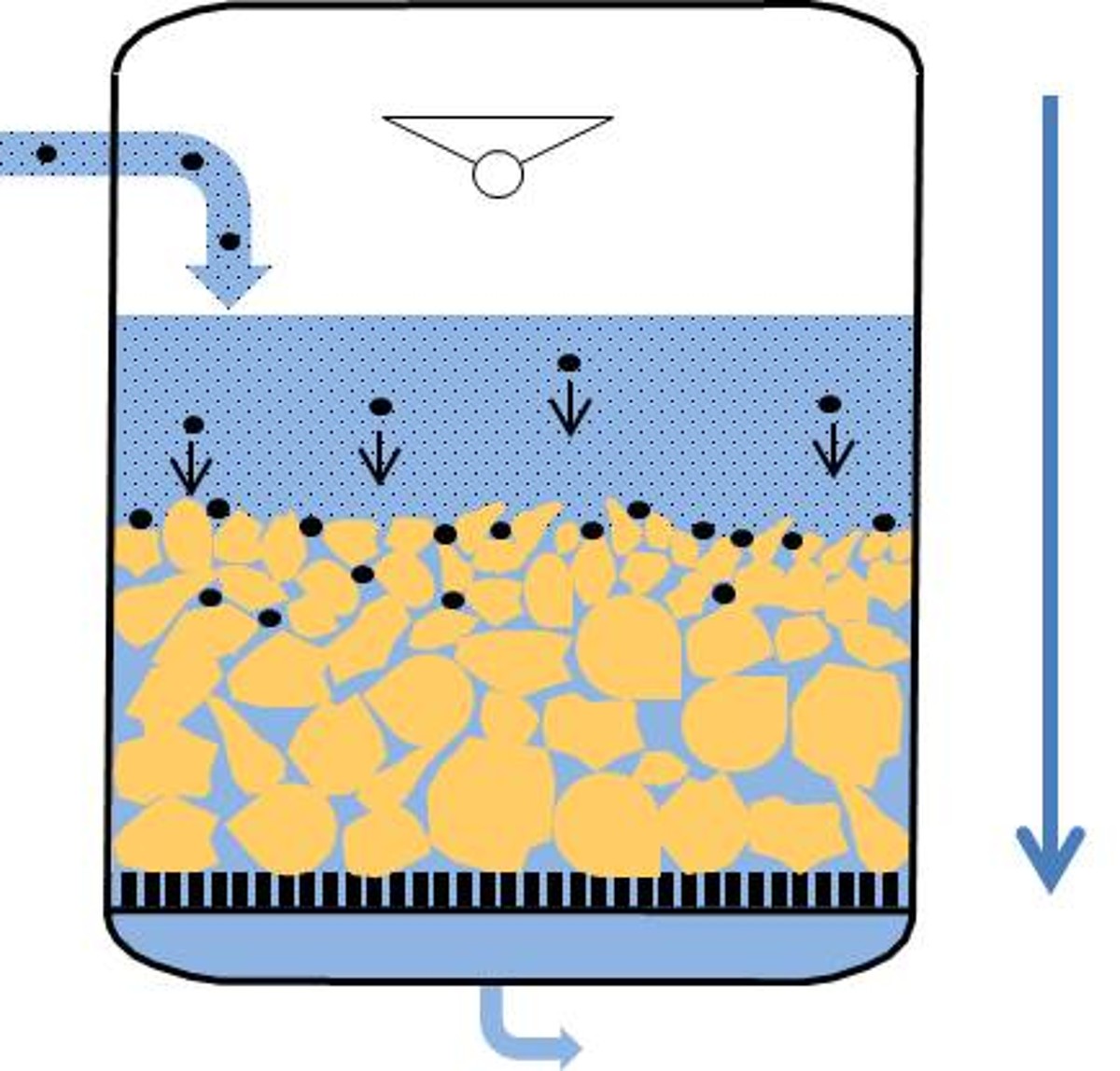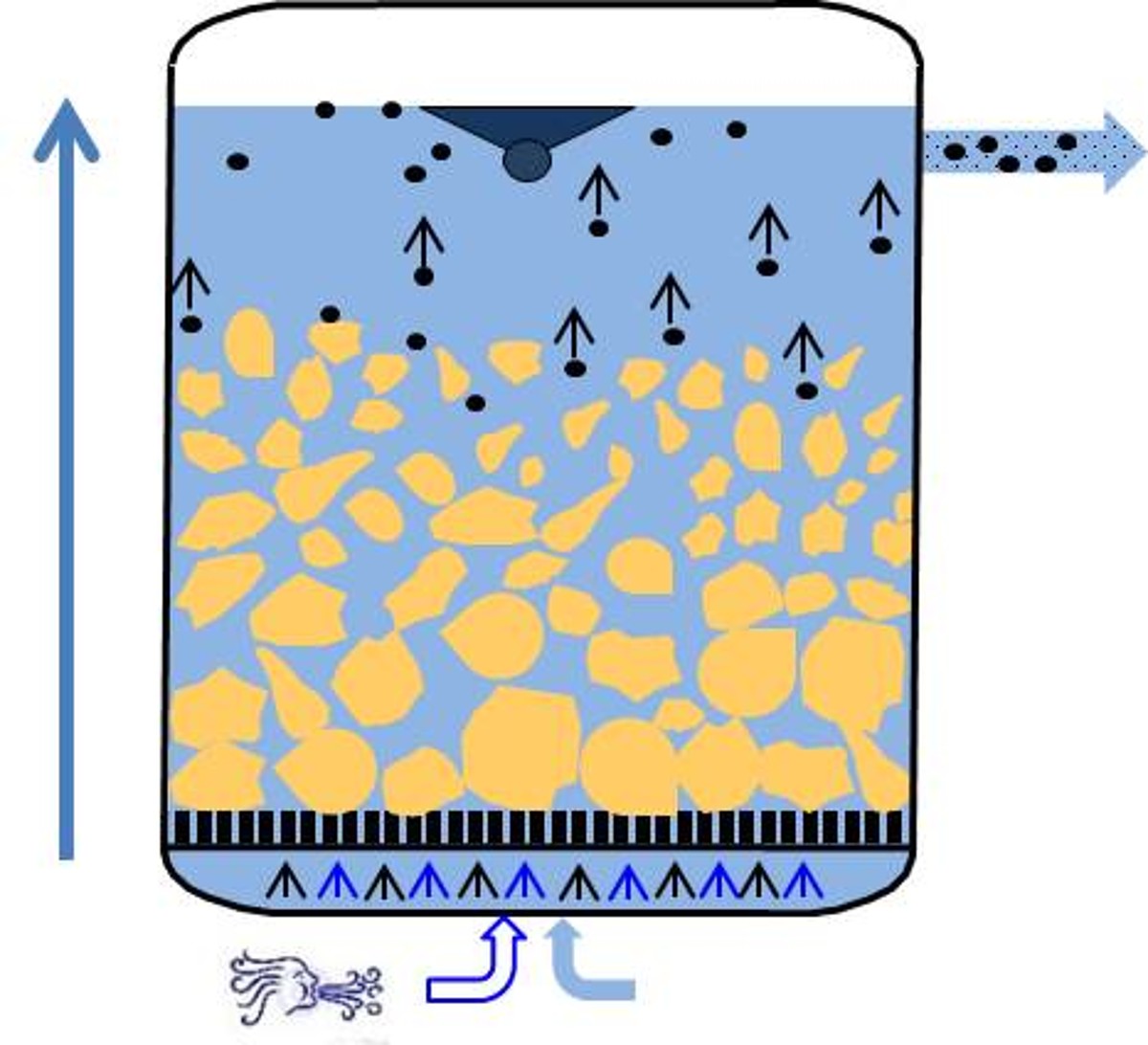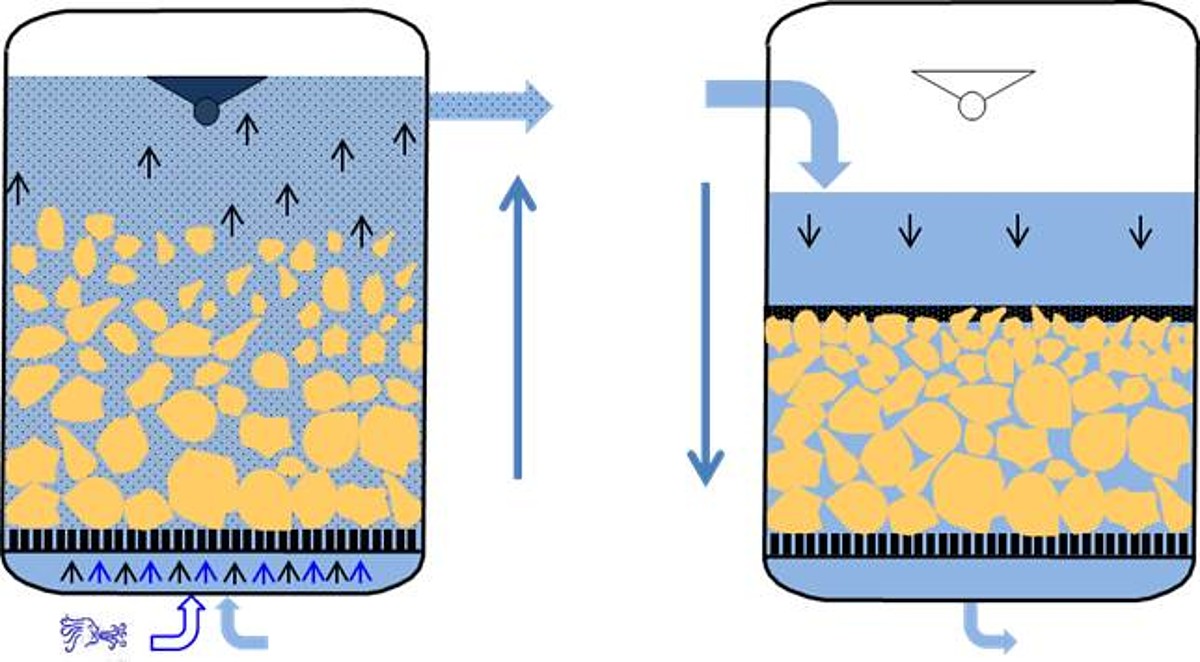Filtration principles
2.1 General
Generally filtration in water treatment is a method to separate solids from a suspension. Filtration is a mechanical separation processes, which based solely on a physical basis.
The terms filtration, filtering and draining are used interchangeably.
The filtered liquid is called filtrate. The residue or filter cake remains in the filter. The loss of pressure is the pressure drop, which is occurring during the filtration, also referred as filter resistance. By filtering the filter off solids form an increasingly dense layer on the filter medium.
In water treatment, the mixture to be separated passes through a filter consisting of filter products usually filter sand and filter gravel (AQUAGRAN®). The filter material constitutes a resistance to all the particles of the mixture to be separated. Through the process, particles, which are considerably smaller than the resultant through the bed void volume between the individual grains are retained also. The pores of the filter material are reduced by the deposition of the retained substances more and more.
After building up a sufficiently thick filter cake a complete separation of the particles would be given, however, though the flow resistance of the filter increases also significantly so that in technical applications an intervention is necessary long before. It is also possible that the particles to be removed are no longer be retained. In this case one speaks of filter break or crash.
To prevent both, the filter cake or the residues must be removed regularly by backwashing. In case of backwashing, the filter process is reversed and the impurities of the filter are rinsed.
In the water treatment commonly used terms are:
First filtrate:
Is the first direct incoming water after rinsing. It usually not match the high demands of drinking water treatment.
Fluidization:
Transition of the filter medium from a fixed bed in a fluidized bed during the filter flushing.
Filtration and cleaning principle (quartz grains AQUAGRAN®)
The two basic operating modes of water filtration are shown in figures 2. and 3.
The polluted raw water is fed to the filter, the dirt particles are deposited on the filter sand, and increase gradually the pressure loss (they "clog" the filter"). In technical installations the pressure drop is measured automatically. If a (defined) value is reached which is no longer guaranteed a meaningful operation of the filter, backwashing is initiated.
While backwashing fresh water and/or air pulses are carrying out from the bottom of the filter. By from the bottom up pressure the pressure which built up from the bottom the individual grains ‘float apart’ (technically = it 'fluidise', ‘the process is fluidization’). It is also called an expansion of the filtration bed.
In multilayer filter the lighter filter carbon is above lighter filter carbon (filter carbon N - AQUAZIT®, filter carbon H - AQUALIN®) is located in the multi-layer filter above. The filter carbon filters the coarsest particles and has a significantly larger expansion at the same flow (therefore coarser particles are better to rinse).
Due to the expansion process two things happen in the filter bed.
⇒ | On the one hand, the pore volume increases between the "floating" particles in the filter bed. As a result, the bound in the interstices dirt particles float freely along with the flow. Via differently removal devices the dirt particles are discharged with the waste water and externally deposited or processed. |
⇒ | On the other hand the grains classify during the sinking phase. After a number of flushing cycles the grains are sorted according to weight (big lie down - small lie above). |
In multilayer filter different sized filter sand and -gravel are installed under a layer of filter coal. The larger particles are the bottom of the filter and serve two purposes.
Installation and peeling
Even with the most careful handling of all filter products, they can loosely strewn about, caused by transportation and installation. All filter products are loosely poured by abrasion, caused by transportation and installation even with the most careful handling. EUROQUARZ recommends to install all products hydraulically (see also www.euroquarz.com/services-and-downloads/umgang-quarzsand-quarzkies/details-for-installation/installation-aquagran/ ).
Nevertheless an abrasion is also produced by this method. After installing the very fine particles "fines" should be removed. Best is to make several times of backflushing, typically after installing any filter layer at least after installation of the filter sand. By the above described process of classifying the fine material gradually settles on the surface of the filter sand.
.
Afterwards the water is lowered (so that the surface can be walked on) and the fine layer is mechanically removed (for example, with a shovel). This process is called "peeling". Without taking the peeling is always a more or less disturbing separation layer above the filter sand ( if applicable under the filter carbon). The filter has from the beginning an (unnecessarily) increased pressure loss, which has no advantages in the filtration. By installing porous products must be ensured that they are sufficiently strong watered before installation. Without taking the peeling, there is always more or less a troublesome.
Turbidity
Any turbidity of the water is caused by particles contained therein. Particles in drinking water are generally undesirable and therefore to minimize. This is common with the described method.
Suspended solids maybe contained :
- Agglomerates
- aggregates
- mineral solids
- organic solids.
These are collectively referred to as "particles" or "suspended matter" and are not soluble in water. If the particles are of such a nature due to their density or size, they do not settle, they are called "suspended". All particles cause a swift through the liquid, light beam that is not “smooth” passing, but is scattered. If the light is scattered, it is called a turbidity.
It should be noted that even the presence of small air bubbles leads to a turbidity effect. These have to be excluded.
In practical application, only optical methods may be used for measuring turbidity. There are two basic and different methods, wherein particularly the wavelength of light used and the angle measurement plays an important role.
In one method, the light scattering is measured and the result is obtained in FNU (Formazine Nephelometric Units). In the other method, the particle concentration (and size) is measured, which is stated in particles per mL. Both methods have advantages and disadvantages and can not be converted into each other. Technically, the particle analysis is more suitable for the operation, while the measurement of scattered light is more of a laboratory method.
In the Drinking Water Regulations (2001), the limit of NTU is at the output of the water distributor 1.0 NTU. Values between 0.1 and 0.2 NTU are desirable.
Please see further Filter products

Dipl.-Ing.
Holger Vespermannsales manager, proxy holder
| +49 02362 - 2005-30 | |
| +49 02362 - 2005-99 | |
| send |





